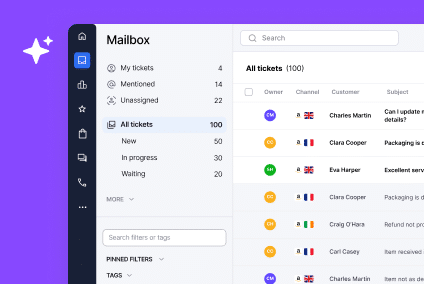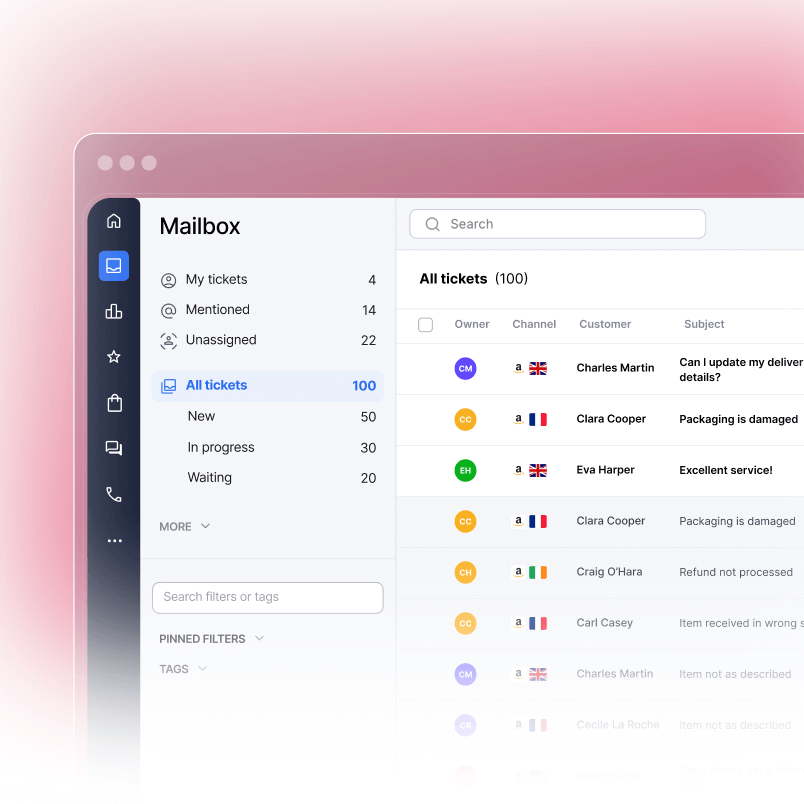Your support inbox holds gold. Every customer question, complaint, and compliment reveals what actually stops people from buying. Most ecommerce teams treat support and marketing as separate departments. They shouldn’t be. When you tap into the patterns buried in your support data, you unlock a direct line to customer intent. This guide shows you how to turn customer service insights into a smarter marketing strategy.
What Makes Customer Support a Marketing Asset
Your support team talks to customers at critical moments. Before purchase. During checkout hesitation. After the box arrives damaged. These are the moments when people ask the questions your marketing can’t anticipate. They reveal the friction points, objections, and confusion that block conversions. Most of this data sits in your helpdesk and never reaches your marketing team.
Here’s what shifts when support and marketing align. Your messaging becomes more relevant. Your ads address real objections instead of assumptions. Your product pages answer the questions customers actually ask. Your email sequences follow where people get stuck. This isn’t theory. It’s pattern recognition built on thousands of real interactions.
Why Your Support Data Matters
Support data reflects customer behavior in real time. When 150 people ask about shipping costs before they buy, that’s not a question to bury in your FAQ. That’s a signal to put shipping transparency front and center on your product pages and ads. When your post-purchase support team sees customers returning items because sizing is unclear, that’s marketing feedback. Your product descriptions need work.
The cost of missing these signals is concrete. Unaddressed objections kill conversions. Confusion leads to returns. Poor communication drives refunds and chargebacks. Each of these outcomes costs you money and customer lifetime value. According to research, companies that actively listen to customer feedback see a 25% increase in customer retention rates. When marketing and support share data, you prevent problems instead of reacting to them. Understanding the advantages of negative feedback helps you reframe complaints as strategic insights rather than obstacles.
Types of Customer Service Data Worth Mining
Not all support tickets matter equally. Focus on these categories.
Pre-Purchase Questions
These are your roadblocks to conversion. Customers ask about shipping times, payment methods, product availability, guarantees, and sizing before they commit. Example: 200+ questions about whether your fabric waterproofs means you need to add that to product images and headlines.
Objection Statements
Listen for language like «too expensive,» «not sure if this fits,» «will this work for my setup,» or «how long does delivery take.» These are the exact words blocking sales. Your ad copy and landing pages should address these objections head-on.
Product Confusion and Misinformation
Some customers think your product does something it doesn’t. Others misunderstand the features or benefits. This gap between what they think you sell and what you actually sell creates returns and negative reviews. Your marketing and product pages need clarity here.
Post-Purchase Issues and Complaints
Returns, damaged goods, quality concerns, and delivery delays tell you where the product or fulfillment process breaks down. This informs content strategy. You may need comparison guides, setup videos, or clearer care instructions.
Common Churn Reasons
When customers cancel subscriptions or don’t repurchase, track why. Price sensitivity. Unmet expectations. Lack of product fit. These insights guide your retention strategy and help you target the right audience in the first place.
Turning Support Insights Into Marketing Action
Your support data becomes useful only when you act on it. Here’s how.
Refine Your Website Messaging
Build your product pages and descriptions using real customer language. If your support team answers the same size chart question daily, add a sizing guide to your product page. If customers ask «does this come assembled,» answer it before they ask. Pull direct quotes from support conversations and use them in your FAQs.
This isn’t guessing at what customers want to know. It’s responding to what they actually ask. When you do this, conversion rates typically improve because you remove friction. People feel like your brand understands them. Check out how top ecommerce brands use customer feedback to inform their product page optimization and see measurable lift in conversions.
Improve Your Ad Targeting and Creative
Your ads should address the objections your support team hears daily. If customers worry about fit, highlight your return policy in ad copy. If they ask about materials, feature that durability claim. If they want to know about warranty, lead with it.
Use the exact words customers use in their questions. If they ask «will this fit my space,» use that phrase in your headlines. If they say «not waterproof enough,» prove your product is with specific claims, not vague language. This alignment between what customers worry about and what your ads promise builds trust and lowers your cost per acquisition.
Boost Your Email and SMS Campaigns
Segment your email list based on support history. A customer who asked about sizing before buying is a candidate for a follow-up sequence about fit and returns. A customer who had a shipping delay becomes part of your loyalty sequence; they need reassurance.
Trigger campaigns after support interactions. When someone contacts support with a question, send them educational content on that topic in their next email. When a customer experiences a problem that gets resolved, include «we’re here to help» messaging in your post-purchase flows. This turns support from a cost center into a retention lever.
Build Content That Answers What Customers Ask
Your support backlog is a content roadmap. Every common question is a blog post, video, or help doc waiting to exist. If 50 customers ask «how do I know my size,» create a sizing guide. If people ask «how long does shipping take from the US to the UK,» create comparison content.
This approach builds organic search traffic. It also gives your support team resources to share instead of answering the same question manually. You reduce support volume while improving the customer experience. It’s a win both directions.
Setting Up a CX-to-Marketing Feedback Loop
Data only matters if it flows between teams. The entire process is about Transforming E-Commerce with Data: From Insights to Action for Superior Customer Journeys.
Tag and Categorize Tickets Consistently
Create a tagging system your support team uses daily. Tags like «pre-purchase-shipping,» «objection-price,» «product-confusion,» and «post-purchase-quality» let you track patterns. Make tagging part of the support workflow, not an afterthought. Implementing customer service automation tools helps standardize this process and ensures your team tags consistently without adding manual burden.
Share Dashboards Between Teams
Build a shared dashboard where marketing sees support trends in real time. Which questions come up most? What objections block sales? Where do returns spike? Your marketing team shouldn’t wait for a monthly report. Real-time visibility creates action.
Schedule Regular Syncs
Set a weekly or bi-weekly cadence for support and marketing to review data together. 30 minutes focused on this builds alignment. In these meetings, discuss top support issues, brainstorm messaging changes, and assign action items. Over time, you’ll see how support insights directly improve marketing outcomes.
Use Integration Tools
Connect your helpdesk to your marketing stack. If you use eDesk for support and Klaviyo for email, look for ways to pass data between them. When a customer asks a specific question in support, that data can inform their email segment. When an email campaign addresses a known objection, your support team knows why inbound volume on that topic drops. AI-powered customer support tools make this integration seamless, automating data flow between platforms so your marketing team gets real-time insights without manual pulls.
How This Works in Practice
Here are concrete examples of CX-driven marketing wins.
A home goods retailer saw 300+ support tickets asking «is this waterproof?» They added a waterproof confirmation badge to product pages and included waterproof claims in ad headlines. Conversion rate increased 12% within six weeks.
A fashion brand’s support team tracked that 40% of returns mentioned «sizing ran small.» They added a prominent size chart, added customer photos from different sizes, and updated ad copy to mention «true to size.» Returns dropped 18%, and repeat purchase rate climbed. This aligns with eDesk’s approach to turning customer feedback into product improvements and messaging refinements.
An electronics company noticed support had to educate 60+ customers monthly about compatibility. They created a five-minute setup video and linked to it from product pages. Support tickets on that issue fell 55%.
A subscription box company’s support logs showed customers didn’t understand the renewal date. They added renewal messaging to confirmation emails, updated their FAQ, and triggered a reminder email five days before renewal. Cancellations due to confusion dropped 23%. Retention strategies built on real customer data lead to measurable business impact.
Final Thoughts
Customer support and marketing aren’t separate. They’re two parts of the same conversation with your customers. The insights buried in your support data are real. They come from thousands of actual conversations. When you surface those insights and act on them, your marketing becomes more relevant, your ads stop guessing, and your customers get answers before they have to ask. Start by identifying the three support questions or objections you hear most. Then commit one piece of marketing real estate to addressing that question better. You’ll see the impact quickly.
FAQs
How does customer service data improve ecommerce marketing?
Support data reveals real objections, questions, and friction points blocking purchases. Your marketing can then address these directly. Instead of guessing at what customers worry about, you respond to what they actually ask. This builds trust, lowers friction, and typically increases conversion rates and customer lifetime value.
What kind of support data should marketing teams focus on?
Start with pre-purchase questions, common objections, product confusion, post-purchase complaints, and churn reasons. Tag these consistently so you can spot patterns. The goal is to find the high-frequency issues that affect multiple customers, not one-off edge cases.
How do I get support and marketing to work together on this?
Create a shared tagging system, build a shared dashboard, and schedule weekly 30-minute syncs between the teams. Make data visible and actionable. Assign clear owners to implement changes based on support insights.
Can I integrate helpdesk data with Klaviyo or GA4?
Most modern helpdesks connect to marketing and analytics platforms. eDesk integrates with major ecommerce platforms. Check your helpdesk and marketing tool for native integrations or use a data platform like Zapier to connect them. The goal is to pass support data into your email segmentation and marketing analytics.
How long does it take to see results from this approach?
You can start small and see results within 2-4 weeks. Pick the top three support issues. Make one marketing change for each. Track the impact. Most teams see measurable improvements in conversion rate, customer satisfaction, or support volume within 30 days.
What tools should I use to manage this workflow?
eDesk helps you tag and organize support data so it flows to your marketing team. Combine it with your email platform like Klaviyo and your analytics tool like GA4. Set up a simple Google Sheet or Slack dashboard to track top issues and marketing actions taken. Research shows that teams using unified customer data platforms see 40% faster time-to-action on CX insights. You don’t need complex software. You need visibility and commitment to the process.




